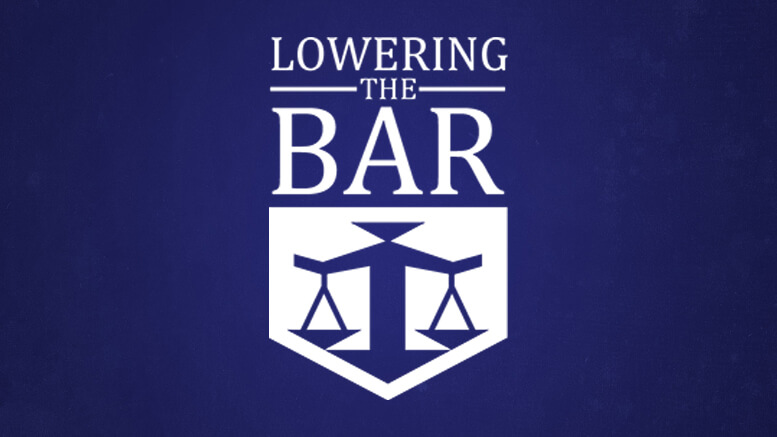You might not consider Utah the most progressive state, but it has become the first to grant its citizens a controversial right that many have long been denied, proving that the law does evolve. Utah has now become the first state to officially allow its citizens to sue themselves.
As the Salt Lake Tribune reports (thanks, Mark), a unanimous panel of the Court of Appeals ruled on February 15 that Utah law allows a decedent's heir and the personal representative of his estate to sue the driver who allegedly caused the accident that killed him. That wouldn't be unusual except that in Bagley v. Bagley, those are all the same people.
The two plaintiffs in this case—the decedent's heir and the personal representative of his estate—brought a wrongful-death claim and a survival action against the driver alleged to have caused the accident. Bagley finds herself on both sides of this dispute because not only is she her husband's heir and the personal representative of his estate, she is also the defendant driver whose negligence allegedly caused the accident.
That's right. She's all three parties on both sides of the case.
The court's opinion is pretty mindbending, as you might expect. I mean, how do you even discuss a case in which there's only one party who is two plaintiffs suing herself as a defendant? Well, the court sets it all up this way:
Barbara Bagley, acting in different capacities, appears as both the appellants and the appellee in this case.
Okay, hold up. Just to be clear, Bagley is the two plaintiffs and Bagley is the defendant that she (the two plaintiffs) is suing. The trial court ruled against Bagley the two plaintiffs and in favor of Bagley the defendant. So on appeal, Bagley the two plaintiffs is also Bagley the two appellants, and Bagley the defendant is also Bagley the appellee. Bagley is all the parties. So you could just as well say that Bagley is actually six people in this case (two plaintiffs, two appellants, one defendant, and an appellee), or that she is four people on one side and two on the other, and how many people she is depends on which court the case is in. Got it? Back to the court:
Barbara Bagley, acting in different capacities, appears as both the appellants and the appellee in this case. Bagley represents the estate of Bradley M. Vom Baur [who, confusingly, was not named "Bagley."] She also appears on her own behalf as Vom Baur's heir. We refer to these two roles collectively as Plaintiffs. Bagley is also the defendant and alleged tortfeasor ([and we will refer to that role as] Defendant). Defendant's interests in this case are represented by her insurance carrier.
Aha, insurance carrier. So here's what's going on: Bagley the personal representative of her husband's estate is suing Bagley the defendant who allegedly caused the accident. Bagley the heir of her husband has also joined as a plaintiff because she has an interest in the proceeds if Bagley the estate representative collects. Because Bagley the defendant has insurance, Bagley's insurer is representing her because it would have to pay the judgment to the husband's estate if Bagley (again the defendant) is found liable.
For killing the husband.
The legal issue is this: Utah's wrongful-death statute says a person's heir or personal representative can sue whoever caused the person's death when the death "is caused by the wrongful act or neglect of another." The defendant(s) argued, and the trial court agreed, that this means "of someone other than the heir or personal representative." That is, the heir or representative can sue as long as they didn't cause the death. But the plaintiff(s) argued that it means "of someone other than the decedent." That is, the heirs can sue as long as the decedent didn't kill himself. The Court of Appeals has now agreed with that.
After wrestling with this for a while (too long, really), I think the Court of Appeals is right. Seems like the statute can be read either way, but this way is closer to the plain language. The real problem, I think, is not the statute but the procedure.
There are two separate actions here, or should be. The first one is a contract action, because Bagley had an insurance policy that pays off if she accidentally kills someone while driving. (Intentional killings are an entirely different situation, as you would expect.) She did that. Pay up. The second one is an action by the husband's estate against the person who caused his death. Also not controversial. But here the two separate actions have been unnaturally joined in carnival-freak-show fashion by somebody's decision to make Bagley herself the estate representative. And that is where all the brain-hurtingness comes from. Appoint somebody else and I think most of the problems disappear, one way or another.
I notice that in footnote 4 of the opinion, the court states tersely that "The decision to appoint Bagley as personal representative of [the] estate is not before us on appeal." I have a feeling the judges wish it had been, or that they could get hold of whoever made that decision, at least.
Note: some of you may not know that "Autolitigation" in the category tags below refers to this sort of case—that is, not "auto[mobile] litigation" but a case where somebody sued or tried to sue himself or herself, intentionally or not. If you thought this was the first time somebody had tried it, (1) you misunderestimate the human race and (2) you might want to take a look at that section.
